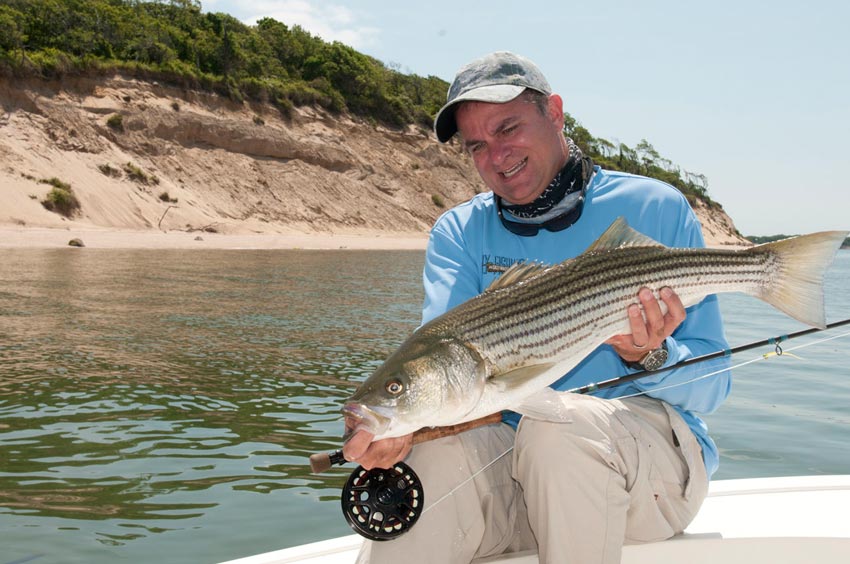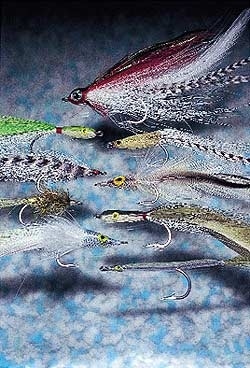
Most people probably associate striped bass with cold New England waters, but the truth of the matter is that these fish are found throughout much of the coastal U.S. from Maine right around to Oregon.
No one who fly fishes for stripers does so casually. In fact, even when they are not on the water fishing, many fly anglers who hunt stripers constantly work to develop better ways to catch them. They tie new patterns and flies, research tides, watch water temperatures and bait runs and count the days until the first spring schoolies show up. Then the fun begins as they fish right on through the fall. Like the changing of the seasons, it’s a cycle that never ends.
Stripers are not a complicated fish, but trying to understand their nuances may lead you to think otherwise. You might assume that because they range over so large an area and live in a variety of habitats including shores, bays and estuaries, that fishing methods would vary tremendously from location to location. Not so.
One of the most important factors to consider when chasing stripers is water temperature. Temperature dictates almost all behaviors in these fish. For example, on the East Coast spawning begins around April when the water temperature reaches about 58 degrees, and lasts through mid-June. (Spawning itself occurs up rivers and inlets, where there is a constant flow of running water. The eggs must be suspended in a running current for several days or they will not be viable.)

From a feeding perspective, “when the water is cold, say around the mid to high 40s, there isn’t a lot of feeding going on, and the fish are hanging around the bottom,” says Lou Tabory, fishing author and longtime striper fisherman. “Likewise, when the water is hot, fish feed more at night and slow up during the day. Water between 55 to 65 degrees is perfect.”
Spring-run stripers usually tend to be smaller, with a few larger fish mixed in. The largest fish show up post-spawn and stay through the fall. Larger fish tolerate cooler temperatures better than smaller ones. This can be important to remember because larger fish will invade cooler water to chase spawning bait into estuaries and rivers. Nearshore, deeper, cooler water may hold big fish when the smaller fish show up in the shallows and flats. Shallow water, on the other hand, will also hold the small early season stripers because it warms more quickly.
Because of their range, stripers are found in nearly every type of coastal environment imaginable, but no matter where they are found they’ll orient themselves around structure. Ledges, rocks, rip lines, inlets, depressions and any other features that might offer a location to lie in ambush are prime spots to explore when searching for stripers. Stripers also frequent sandy beaches and flats as well. “Many times stripers will hang out at the edges of shallower water to ambush bait as the water rushes out of the shallows with the changing tide,” says Tabory. He also says stripers in shallow water tend to behave a little like bonefish and become spooky, particularly if they are heavily fished.
Naturally, different locations and regions offer different forms of structure and different kinds of bait. For example, the types of structure found in an estuary will be very different from a sand flat. And, as for differences in bait, according to Dan Blanton, who guides and fishes regularly for stripers in the San Francisco Bay area, “synthetic materials don’t work well on the West Coast because they tend to be more translucent in the water. But that’s perfect for flies on the East Coast because the bait tends to be more translucent there.”
Generally, stripers feed mostly on small baitfish like shad, alewife, herring, menhaden and even smaller stripers. However, stripers will also readily take squid, crabs, lobster, sand eels and worms, not to mention almost anything else they can catch. The larger the bass, the larger the prey items they prefer, but as the saying goes, elephants still eat peanuts.
It is also important to remember that striped bass are primarily nocturnal. As a result, their lateral line is highly sensitive and can pick up vibrations from more than 100 feet. “That’s why when you fish dark or turbid waters like we have around San Francisco, you need a fly that moves water,” says Blanton. Tabory agrees: “I think movement is very important, too. I prefer flies made with active materials that mimic crippled bait. It’s not always good if your fly looks like one of a thousand; sometimes you need your fly to stand out and look and act differently,” he says.
“A striper is a striper no matter where they live, but the most important thing to remember is to fish with a fly that matches the bait the fish are feeding on that day,” says Blanton. “Size and color are vital, although size seems to be the more important of the two.” When it’s difficult to determine how big the fly needs to be, Blanton recommends beginning with a large fly, followed by the smallest fly and then working the middle ground. However, Tabory suggests using larger flies even when only smaller bait is present.
In the end, the most important factors in finding stripers, no matter where or when you fish for them, seem to be locating bait in the right temperature water.









